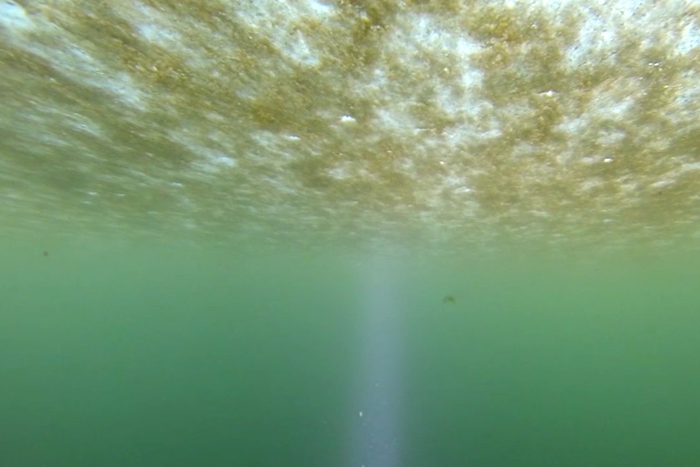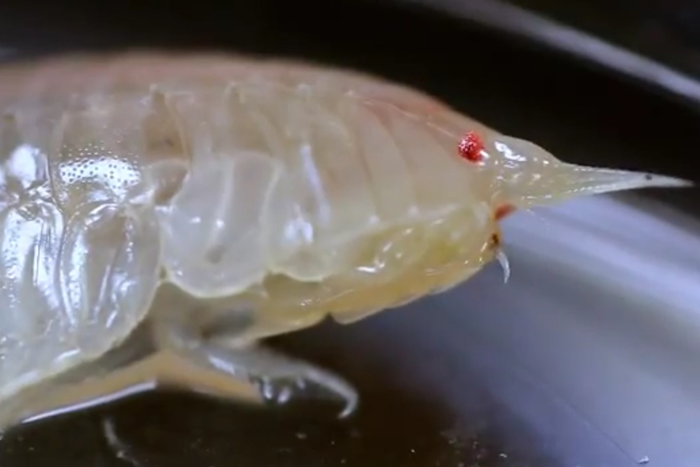
Researchers Crack Sea Ice to Expose Arctic Food Web (VIDEO)

Charlie Heck, multimedia news editor at the U.S. National Science Foundation, contributed this article to Live Science's Expert Voices: Op-Ed & Insights.
Traveling to a town near the top of the Earth, a team of scientists is studying a creature at the bottom of the marine food chain — microscopic algae. In Barrow, Alaska, the marine ecologists are traveling across sea ice, a seemingly desolate landscape that teams with marine life. With support from the U.S. National Science Foundation (NSF), Craig Aumack of Columbia University and his collaborators have come to the ice to investigate how the algae connects to the marine ecosystem, and which marine organisms depend on it.
Some algae live dormant in the ice all winter, bloom when the spring sunshine kick-starts a growth cycle, and, eventually, migrate down to the bottom of the ice and enter the water column where they provide a nutritious dietary food source to many marine organisms. Going forward, the changing climate could mean disruptions to that cycle.
In the Arctic, the algae could be considered a "canary in the coal mine" for climate change, said Aumack — the microorganisms are early sentinels of a changing ecosystem. [Ancient Arctic Algae Record Climate Change in 'Tree Rings' ]
Below, Aumack provides a Q+A with context for the research. Learn more in this video below and see images from the field study in "Sea Ice Algae is Staple of Arctic Food Chain (Gallery )."
NSF: Can you give us an idea of what a typical day in Alaska is like for you and your team?
Aumack: A typical day of field work actually begins the previous evening when we discuss the sampling plan and then organize the materials and equipment we will need on the ice the following day. First thing the next morning, we make a group lunch for the field, which usually consists of soup, crackers, granola bars and other snack items that can be easily consumed with gloved hands. Afterward, we depart for the staging area (a warehouse where all the field gear is stored) where we pack a sled with all our gear and get suited up for work on the sea ice. Then, with a guide and bear guard (a trained professional who accompanies the researchers to protect the team from bears and to educate them about bear safety), we use snow machines to traverse the sea ice to our field site. Once there, we typically follow our pre-arranged plan for sampling the ice, as well as the water and sediments below the ice. This includes drilling ice cores, using nets to sample the water column, deploying sediment grabs to capture organisms living in the sediments, and using a camera system for filming under the ice. Once all the samples have been collected, we pack up the sled and head back to the lab where samples are sorted, processed and stored for future lab analyses. It is usually a long field day, starting at around 8:00 a.m. and lasting until 8:00 to 9:00 p.m. It usually takes us an additional 1 to 2 days in the lab to process the samples we collected. Then we head out again and collect fresh samples, because during the Arctic spring, conditions change fairly rapidly within the ice.
Sign up for the Live Science daily newsletter now
Get the world’s most fascinating discoveries delivered straight to your inbox.
It's cold and the wind is unpredictable; wind speeds and velocities change very rapidly. Weather conditions change very rapidly and you always have to be aware of that. You certainly don't want to be too far out if wind speeds increase all of a sudden and whiteout conditions occur. You have to be aware that the environment we're working on is, in fact, sea ice, and it is changing as we're standing on it. Are we afraid we're going to fall through? No, but are there cracks that form behind us? Yes. You always have to keep that aspect in mind. It certainly adds to the alertness of fieldwork out on the sea ice.
NSF: What organisms are dependent upon algae in the marine ecosystem?
C.A.: Excellent question, and one that is not easy to answer. It is actually the basis of our research, so that is exactly what we are trying to find out. Algae (both in the water column and in the sea ice) are the base of the food web in nearshore Arctic marine ecosystems and are therefore imperative for sustaining the high productivity of Arctic environments. However, we are really trying to differentiate the importance of sea ice algae versus the algae that live in the water for different kinds of consumers (organisms that receive energy by consuming other organisms). We have some evidence that suggests that several kinds of consumer organisms, ranging from single-celled predators in the water, to worms and crustaceans living in the sediments, prefer eating ice algae to other kinds of algae. It is possible that the ice algae are more nutritious. We are still investigating if this preference is a necessary dependence and how the consumer communities would respond to changing sea ice conditions if ice algae became less abundant.
NSF: What's the difference between ice dwelling algae and algae that grow in the water column?
C.A.: The algae found inside sea ice are generally quite distinct from those found in the water. Each group is adapted to thrive under the conditions they live in. Ice algae are most likely derived from algae that originally inhabited the sediments, and they are capable of attaching to, and moving around on, surfaces. Water column algae are more subject to sinking and have developed different strategies to cope with living in a moving, fluid environment.
NSF: How thick is the ice you are working with? What are some of the tools you are using to reach the algae?
C.A.: It varies annually, and obviously thins during the course of the summer season. On average, the sea ice is approximately 1.5 meters to 2 meters thick during the sea-ice algae bloom. We collect cores out of this ice layer using an ice corer, which is kind of like a big, hollow drill bit. It drills out a cylinder of ice that goes all the way down to the ice-water interface.

NSF: What does this ice dwelling community contribute to the underlying marine life?
C.A.: The ice dwelling community builds up within the ice in the spring. This represents a nutritious dietary resource to marine life under the ice, but it is mostly available to those underlying organisms after it is lost from the sea ice. This loss of algal material from the ice happens in large pulses that may last for only a few days in late spring. These pulses are the result of increased light, warming of the ice, and active movement by the algae out of the ice into the water column. Several studies have indicated that many organisms, from benthic worms to pelagic crustaceans, have behaviorally adapted their life cycles to take advantage of organic material leaving the sea ice.
NSF: How can climate change affect this particular type of algae?
C.A.: Aside from the loss of the ice habitat itself, we have shown that local climatic conditions can have huge implications on the sea ice community. The abundance, diversity, nutritional quality and sinking velocity of sea ice material is likely significantly influenced by the amount of overlying snow in the area ,which itself is largely dependent on local climatic conditions.

NSF: Why were you excited to catch the jellyfish featured in the video?
C.A.: We had plenty of video evidence indicating that these jellies swim along the bottom dragging their oral tentacles across the sediment. We hypothesized that this was a behavioral adaptation of the jellies to graze upon material that had fallen out of the sea ice and accumulated along the sea floor. In order to test this hypothesis though, we needed to catch some jellyfish, something that had eluded us until that day.
NSF: What are the next steps in your research?
C.A.: We are currently interested in continuing our research on the importance of ice algae to the diets of under-ice consumers, as well as the contribution of ice algae to annual near-shore Arctic marine productivity. Additionally, we are interested how the ecosystem would be affected if ice algae were less common and replaced by algae growing in the water.
Follow all of the Expert Voices issues and debates — and become part of the discussion — on Facebook, Twitter and Google+. The views expressed are those of the author and do not necessarily reflect the views of the publisher. This version of the article was originally published on Live Science.









